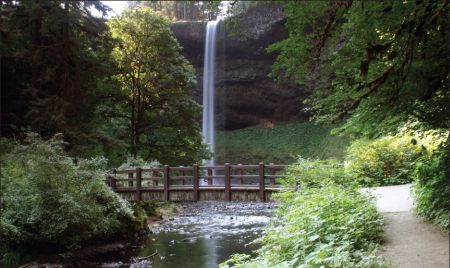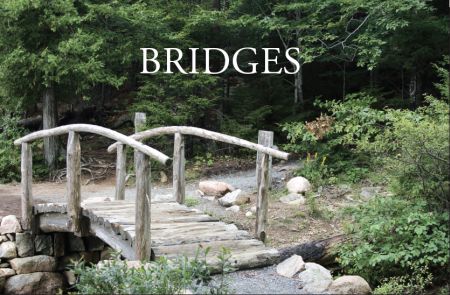
If you have a river or brook on your property, you may want to construct a simple bridge. Building these bridges can be fairly easy, especially if you don’t plan on transporting very heavy machinery or cars over them. Here are a few different ways to build basic bridges over streams, creeks, or other rather narrow waterways.
Footbridge
This natural-looking footbridge can be built between 8 feet and 12 feet long.
Excavate the banks of the stream or creek to allow for the building of a small, low rubble or stonewall. The sleepers will rest on this wall. The girders are formed of wooden spars (four are used in this plan). The girders should be between 8 and 10 inches in diameter. Lay the girders down and bolt them together in pairs with six ¾-inch-diameter coach bolts. Wedge the posts to fit mortises in the girders.
The posts and top rails should be roughly 4½ to 5½ inches in diameter and the intermediate rails 3 inches in diameter. Finally, join the rails to the posts.
The bridge should be anchored well if it’s in a place where flooding is frequent, as you don’t want your footbridge floating away in the stream. To do so, drive four short piles into the soil on the inside of the girders, near their ends. Fasten the girders to the piles with coach bolts. The pile tops are hidden by the ends of the floor battens.
Now, if you want to decorate your footbridge, you can use small twigs and nails to make patterns on your bridge.
Small Stream Bridge
If you have a small creek or stream on your property, you may want to construct a simple bridge for easy access to the other side. To build this bridge, you’ll need lumber that is 6 inches wide and 2 inches thick, and additional lumber for the floor and four side braces.
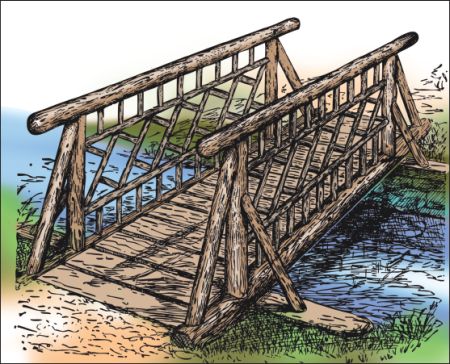
A woodern footbridge.
A cross section of the footbridge.
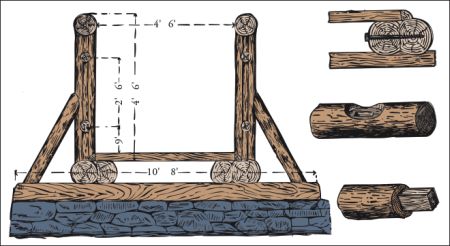
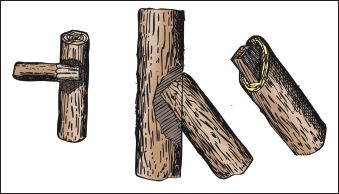
Join the rails of the footbridge to the posts as shown here.
Directions
1. Saw 11 pieces of wood the length required for the two sides.
2. Bore bolt holes 1½ inches from each end. Use ⅝-inch bolts 8½ inches long for where four pieces come together, and use 6½-inch bolts where three pieces meet.
3. Bolt on the A-shaped supports and pieces for the approaches at one time, and then put on the side braces.
4. The sides of the bridge are made of triangles. The first triangle is made of pieces a, b, and c. The second triangle is made of pieces b, d, and e.

A bridge for a small stream.
5. The piers for this bridge may be made of posts, stone, or even concrete, depending on how permanent you wish your small stream bridge to be.
A Very Simple Bridge
Another very simple way of building a bridge across a creek or stream is to find a narrow part of the waterway and then find two logs that are longer than the creek is wide. These logs should be very sturdy (not rotted out) and thick. Place them across the creek, so they make a narrow beam over the water. Each log should have an extra foot at each end of the creek so they can be securely walked upon with no danger of slipping into the creek bed. Place the logs roughly two feet apart.
If the water comes up close to the bottom of the logs, raise them so the bridge does not get washed away in heavy storms or during the course of the stream rising. Raising the bridge will require a bit more work, as each log will need to be set into another log on the edge of the streambed or even into stone to make it more permanent.
Railings can be fashioned like wooden fences (see pages 248–251).
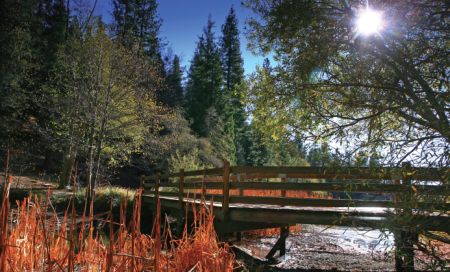
After you have the two base logs secured, find some sticks that are long enough (and relatively thick) to lay across the tops of the two logs. Or, if you have extra plywood or other boards, those can be used as well. Just make sure to place the sticks or boards fairly close to one another, leaving only little gaps between them. Then, once all the sticks have been laid down, secure these by tying twine or rope to them and the base logs.
If you’d like your bridge to last a little longer, you can pave it with clay or fine cement. Using a shovel, coat the bridge with the clay or cement until it’s about 2 inches thick. Then shovel dirt onto the clay mixture, packing it down all over, and make the bridge as thick as you like. However, for just a simple bridge across a narrow stream or creek, the wooden sticks or boards will work just fine and won’t require as much time and energy.
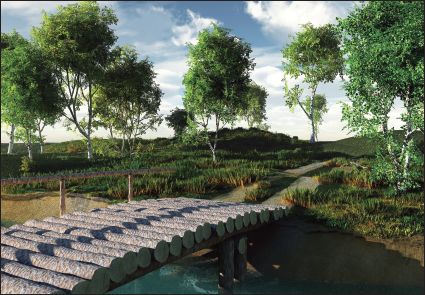
For longer bridges, you will need supports underneath.
